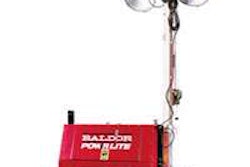How the life of a 1.2-mile-long viaduct in Colorado is being extended, turning a $800 million replacement project into a $21.6 million repair project
by Troy Robinett, Technical Support, CTS Cement Manufacturing Corporation
When Interstate 70 was completed through Denver in 1964, its bridges were designed to last 30 years. The original construction of the interstate highway system was paid for with federal dollars with the states taking over responsibility for upkeep after completion.
ACC workers replace the reinforcing steel with galvanized wire mesh to add structural reinforcement to the concrete.As a result, the highways were designed to meet only the minimum standard necessary for the projected traffic load to avoid having the federal government indirectly subsidize maintenance. Not only was the actual volume of traffic greater than anticipated, funding to replace worn out portions of the highways was not always available when needed and many sections, like this viaduct in Denver, are being used past their planned design lives.
This bridge between State Highway 265 (Brighton Boulevard) and State Highway 2 (Colorado Boulevard) is one of 46 bridges in the metro Denver area said to be in imminent need of repair by the Colorado Department of Transportation (CDOT). Its 60 expansion joints have been corroded by water and salt, resulting in deterioration of the reinforcing steel and the concrete surrounding that steel.
The 1.2-mile-long viaduct has a current sufficiency rating of only 44 out of 100, six points lower than the I-35W Bridge that collapsed in Minneapolis in 2007. CDOT considers the viaduct structurally defective, functionally obsolete and in need of replacement. Replacing the bridge, which is still used for an average of 130,000 to 150,000 vehicle trips per day, would cost $800 million the state does not have.
To extend the life of the bridge until funding for either replacing
The depth of removed concrete cannot be greater than 6 inches, but these sections can be as wide as 8 feet.it or rerouting the highway is obtained, CDOT hired the Denver office of American Civil Constructors (ACC) to repair the failed expansion joints. The goal of the repair project is to extend the life of the bridge for 10 to 15 years. ACC began its upgrade of the bridge’s substructure in September 2008. This structural repair work is part of a larger repair project for the bridge, which also includes replacing bridge railings, reconstructing the median, repairing the substructure of the bridge and improving drainage. The cost of the whole project is $21.6 million.
What the concrete repair work involves
ACC workers begin by inspecting the bridge’s substructure to determine where concrete is damaged and needs to be replaced. Then they jackhammer out the pieces of deteriorated concrete and rebar, continuing until they reach sound concrete. Concrete removal is the most time consuming part of the job. The exposed, undamaged concrete is then sandblasted to create a rough surface for good adhesion of the repair material. The depth of removed concrete cannot be greater than 6 inches, but these sections can be as wide as 8 feet.
“We replace the reinforcing steel and put in galvanized
Completing the job will take about 6,000 55-pound bags of product, which are being used at the rate of roughly 50 bags per night.wire mesh to add structural reinforcement to the concrete, wet the surface, and then we start applying the repair material,” explained ACC Assistant Project Manager Jimmy Jones. CDOT requires that the rebar be encased in concrete within seven days after it is replaced. Two crews of 12 to 15 men are working to make the repairs using seven manlifts, four all-terrain scissor lifts, 20-25 jackhammers and other hand tools.
Due to the larger portion of the project involving temporary lane closures of I-70, all work is done at night and only a small section can be worked on at one time. One interstate lane is closed in each direction at 8 p.m., with a second lane closing at 10 p.m. In addition, either Westbound or Eastbound 46th Avenue, a city of Denver street under the bridge, remains closed at all times. At 5:30 a.m., the workers must be finished so traffic can resume in all interstate lanes or ACC is charged heavy lane rental fees.
To complete the work in the short overnight time frame, a fast-setting concrete repair material was needed. The first product selected could be applied no more than 3 inches deep, which meant two applications were required to repair each damaged area. This product cracked and was found to be unacceptable.
“The setup time of the first material we used for patching just wasn’t fast enough, and when it did set up, it had spider web cracks throughout the job,” noted Chad Smith of White Cap, a Rapid Set distributor located in Denver, Colo. “The workers had to keep coming back to it once it was set up and do another skim coat to make sure there weren’t any cracks.”
In the search for a more suitable repair material, Smith introduced ACC to Rapid Set Mortar Mix, a product included on CDOT’s approval list. A demonstration showed Jones and other ACC staff that this product could be applied 6-inches deep in a single application and that it reached initial set up in 15 minutes. With final setup in 35 minutes, a 2500-psi compressive strength was achieved one hour later, allowing crews to move to the next repair section. No cracking was seen so this product was chosen to complete the job.
“The speed of it, the workability, and the ease of use all impressed us,” Jones said. “It was easy to mix, easy to put on, and it set up really fast.”
The I-70 bridge’s 60 expansion joints have been corroded by water and salt, resulting in deterioration of the reinforcing steel and the concrete surrounding that steel.Rapid Set Mortar Mix is being used for repairing all horizontal and vertical overhead areas covering 5,500 square feet of the substructure of the entire bridge. Rapid Set Mortar Mix is engineered for vertical and overhead up to 6 inches in depth in one application. Completing the job will take about 6,000 55-pound bags of product, which are being used at the rate of roughly 50 bags per night.
Using drills with mixers on the ends, the Mortar Mix is mixed with water to a good consistency in 5-gallon plastic buckets on the ground. Because the bridge is 50 to 60 feet high in some areas, a pulley system as well as manlifts are used to lift the buckets up to the damaged columns, girders and pier caps where the material is needed. Working from left to right, it is poured in, hand shaped and then wet cured by spraying water on it.
Jones is also using Rapid Set’s additive called Flow Control. This additive helps keep the repair material flowable while still retaining the same strength, a property that would be reduced if additional water were added to increase flowability.
“It makes our job a lot less difficult,” said Jones. “We don’t have to form and hand shape the concrete. It makes it more visually pleasing.”
Construction Challenges, Schedule
Because all work must be done at night, lights are needed. In addition, if workers discover they are missing some equipment or run out of materials, “they can’t just run down to the store, so the problem can delay them until the next night,” Smith pointed out. “Afternoon showers here in Colorado play a big part since the location is prone to flooding, which also delays the schedule.” However, because of the size of the job, if workers are delayed on concrete pours, there is always something else that needs to be done.
By eliminating the second application of repair material, Jones estimates ACC is saving 25 percent on completion time and labor costs. No special tools, curing or burlap covers are needed to use Rapid Set. Jones estimates they will now finish the expansion joint repairs on time in December 2010.
“We may add additional crews to make sure it is finished during the warmer weather months,” Jones noted.
The CDOT inspectors are very happy with how it looks and how the finished repairs came out,” Jones said. “It’s more visually appealing than how it would have looked with other traditional repair products. If we have the chance to use Rapid Set again on another job, we’ll use it.”
Article and photos were contributed by CTS Cement Corporation, which manufactures professional-grade cement products for concrete repairs and new construction projects.











